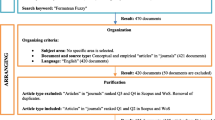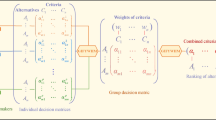Abstract
Dempster–Shafer evidence, rough set and three-way decision are related to each other. They are all theories and methods of handling uncertain information. First, it is required to combine the Dempster–Shafer evidence with rough set theory, and the rough set theory can therefore be applied to obtain the basic probability assignment function of evidence, which allows it to be obtained more objectively. Second, the conditional probability function in the three-way decision is replaced by a value in the belief interval, and three-way decision models are established to integrate the Dempster–Shafer evidence theory with rough sets. Third, by adjusting the value of the belief factor, the decision inference rules suitable for decision-makers of different risk types are obtained. Finally, an example is provided in this case to prove the validity of this model.





Similar content being viewed by others
References
Chen Y-J, Li X-W, Xing R-K (2018) Three-way decisions model based on evidence theory. Comput Sci 45(6):241–246
Hu B-Q, Wong H, Yiu Ka-fai Cedric (2017) On two novel types of three-way decisions in three-way decision spaces. Int J Approx Reason 82:285–306
Ji Jun (2010) The rough set method based on evidence theory. Dissertation, Nan chang: Jiang xi Normal University
Liang D-C, Liu D (2014) Systematic studies on three-way decisions with interval-valued decision-theoretic tough sets. Inf Sci 276(C):186–203
Liang D-C, Liu D, Pedryczb W et al (2013) Triangular fuzzy decision-theoretic rough sets. Int J Approx Reason 54(8):1087–1106
Ling D-C, Liu D (2015) Deriving three-way decisions from intuitionistic fuzzy decision-theoretic rough sets. Inf Sci 300(C):28–48
Ling D-C, Xu Z-S, Liu D (2017) Three-way decisions with intuitionistic fuzzy decision-theoretic rough sets based on point operators. Inf Sci 375(C):183–201
Ma J-M, Zhang H-Y, Qian Y-H (2019) Three-way decisions with reflexive probabilistic rough fuzzy sets. Granul Comput 4:363–375
Mandal P, Ranadive AS (2019) Multi-granulation fuzzy decision-theoretic rough sets and bipolar-valued fuzzy decision-theoretic rough sets and their applications. Granul Comput 4:483–509
Shafer G (1976) A mathematical theory of evidence. Princeton University Press, Princeton
Skowron A, Grzymelta-Busse J (1994) From rough set theory to evidence theory—advances in the Dempster–Shafer theory of evidence. Wiley, New York, pp 193–236
Wang B-L, Liang J-Y (2014) A novel intelligent multi-attribute three-way group sorting method based on Dempster–Shafer theory, RSKT 2014. LNAI 8818:789–800
Wang L-Y, Zhang C-Y, Liu B-X (2016) Dynamic strategy regulation model of three-way decisions based on interval concept lattice and its application. Comput Eng Appl 52(24):80–84 (101)
Xue Z-A, Liu J, Xue T-Y et al (2014) Three-way decision based on belief function. 9th International conference on rough sets and knowledge technology, pp 742–752
Xue Z-A, Wang P-H, Liu J et al (2016) Three-way decision theory based on intuitionistic fuzzy sets. Comput Sci 43(1):30–34
Yao Y-Y (2016) Three-way decisions and cognitive computing. Cogn Comput 8(4):543–554
Yao Y-Y (2018) Three-way decision and granular computing. Int J Approx Reason 103(2018):107–123
Yao Y-Y, Lingras P-J (1998) Interpretations of belief functions in the theory of rough sets. Inf Sci 104:81–106
Yao YY, Wong SKM (1992) A decision theoretic framework for approximating concepts. Int J Man Mach Stud 37(6):793–809
Zhang W-X, Liang Y (1996) Principle of uncertainty reasoning. Xian Jiaotong University Press, Xian
Zhang C-Y, Wang L-Y, Li M-X et al (2016a) Model of three-way decision based on the space of set pair information granule and its application. J Commun 37(Z1):2016242
Zhang N, Jiang L-L, Yue X-D et al (2016b) Utility-based three-way decisions model. CAAI Trans Intell Syst 11(4):459–468
Funding
This work is supported by The Natural Science Foundation of Hebei Province (F2018209374) and The Natural Science Foundation of Hebei Province (F2016209344).
Author information
Authors and Affiliations
Corresponding author
Additional information
Publisher's Note
Springer Nature remains neutral with regard to jurisdictional claims in published maps and institutional affiliations.
Rights and permissions
About this article
Cite this article
Zhang, C., Feng, X. & Gao, R. Three-way decision models and its optimization based on Dempster–Shafer evidence theory and rough sets. Granul. Comput. 6, 411–420 (2021). https://doi.org/10.1007/s41066-019-00201-6
Received:
Accepted:
Published:
Issue Date:
DOI: https://doi.org/10.1007/s41066-019-00201-6




